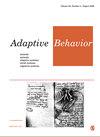Modelling of factors underlying the evolution of human language
IF 1.2
4区 计算机科学
Q4 COMPUTER SCIENCE, ARTIFICIAL INTELLIGENCE
引用次数: 0
Abstract
A central question in the evolution of human language is how it emerged. Based on recent research across disciplines, we identified three processes proposed as potential driving factors behind the evolution of ‘modern’ language phenotype: i) a reduction in reactive aggression entailing a boost in prosociality and cooperation, ii) a change in early brain growth trajectory that impacted structures like the cerebellum and striatum, and thus likely impacted the (procedural) memory circuits these regions support, and iii) a demographic expansion of H. sapiens during the Middle Pleistocene. While extensively researched on their own, the interaction between these three processes has yet to be investigated systematically. We develop an abstract agent-based model to interrogate the relationship between these three factors and how they influence transmission of information within a population, which we take to be the essence of language. The model abstracts linguistic capacity to an ‘array of skills’ and investigates under what conditions the number of skills increases. The results demonstrate that there is an optimal degree of cooperation and memory capacity at which the amount of transmitted information is the highest. Our model also shows that separate linguistic communities arise under circumstances where individuals have high levels of memory capacity and there is at least a certain degree of non-cooperation. In contrast, we find no significant direct effects for population size in the process of linguistic community formation. Taken together, these results highlight the explanatory benefits of combining insights from cognitive science, archaeology, and computational modelling.人类语言进化背后的因素建模
人类语言进化的一个核心问题是它是如何出现的。基于最近跨学科的研究,我们确定了三个过程作为“现代”语言表型进化背后的潜在驱动因素:1)反应性攻击的减少导致亲社会和合作能力的增强;2)早期大脑发育轨迹的改变影响了小脑和纹状体等结构,从而可能影响了这些区域支持的(程序性)记忆回路;3)中更新世期间智人的人口扩张。虽然这三个过程本身被广泛研究,但它们之间的相互作用尚未得到系统的研究。我们开发了一个抽象的基于主体的模型来询问这三个因素之间的关系,以及它们如何影响群体内的信息传递,我们认为这是语言的本质。该模型将语言能力抽象为“一系列技能”,并研究在什么条件下技能数量会增加。结果表明,存在一个最优的合作程度和存储容量,此时传输的信息量最大。我们的模型还表明,在个体具有高水平记忆能力且至少存在一定程度的不合作的情况下,不同的语言社区就会出现。相比之下,我们发现群体规模在语言群落形成过程中没有显著的直接影响。综上所述,这些结果突出了结合认知科学、考古学和计算建模的见解的解释性好处。
本文章由计算机程序翻译,如有差异,请以英文原文为准。
求助全文
约1分钟内获得全文
求助全文
来源期刊

Adaptive Behavior
工程技术-计算机:人工智能
CiteScore
4.30
自引率
18.80%
发文量
34
审稿时长
>12 weeks
期刊介绍:
_Adaptive Behavior_ publishes articles on adaptive behaviour in living organisms and autonomous artificial systems. The official journal of the _International Society of Adaptive Behavior_, _Adaptive Behavior_, addresses topics such as perception and motor control, embodied cognition, learning and evolution, neural mechanisms, artificial intelligence, behavioral sequences, motivation and emotion, characterization of environments, decision making, collective and social behavior, navigation, foraging, communication and signalling.
Print ISSN: 1059-7123
 求助内容:
求助内容: 应助结果提醒方式:
应助结果提醒方式:


